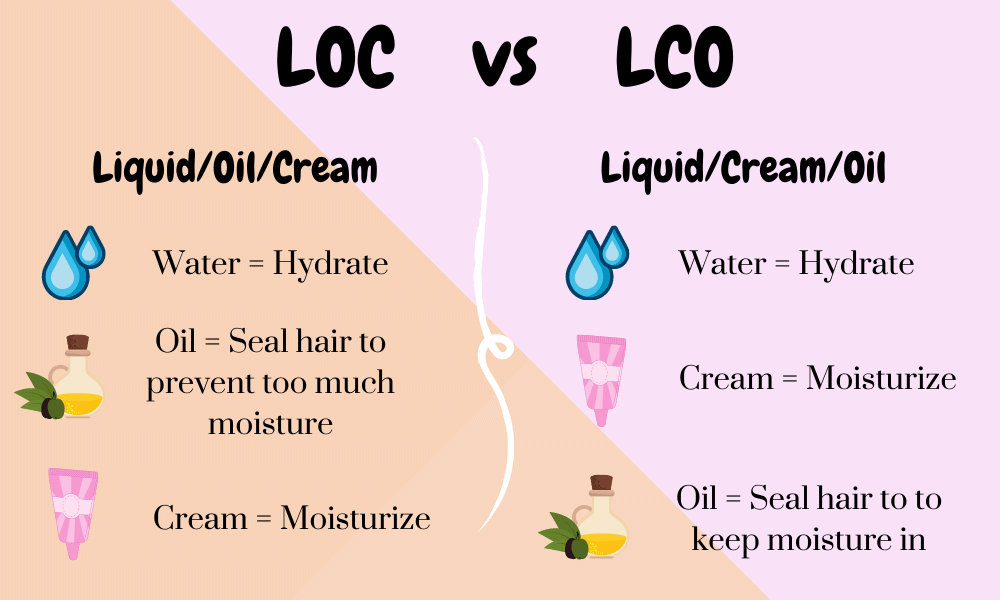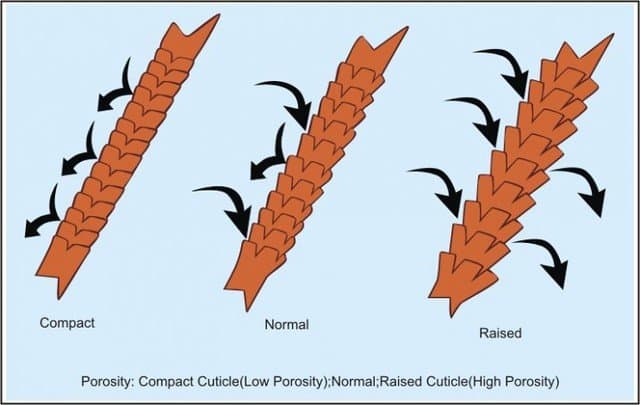LOC and LCO are terms within the curly girl community that you may or may not be familiar with. They refer to two different but similar methods aimed at hydrating curly locks and are often praised for their effectiveness. In this article, we compare the LOC vs LCO methods so that you can determine exactly which one is right for you.

The LOC vs LCO debate has long been discussed amongst the curly girl community as it has not always been clear which method works best for which hair type. It’s important to note that both methods are very effective, but that each method caters to the individual’s hair porosity.
While the LOC method is recommended for high porosity hair, those with low porosity hair will benefit more from the LCO method.
This post contains affiliate links and we may earn if you click on them (at no extra cost to you). Please read our full disclosure policy here.
What Do LOC And LCO Stand For?

LOC stands for liquid, oil, and cream while LCO stands for liquid, cream, and oil.
Both of these methods describe the sequence in which you should apply the chosen products.
These hair care routines are targeted at those with natural hair who are looking to lock in and retain moisture.
This is essential for curly hair growth and hair health.
The LOC and LCO methods are highly effective and can be used every few days to maintain hydration.
It’s not recommended that you use them every day as this can have the opposite effect and lead to product build-up and dryness.
Our Top Picks For The LOC Method
Our Top Picks For The LCO Method
Who are the LOC and LCO Methods For?
The LOC and LCO methods are suitable for:
- Natural, curly, textured hair
- Those who are struggling with dry, brittle, dull hair that’s in need of hydration
Dry, frizzy hair is one of the main struggles that many curly-haired women face.
That is why using a method like LOC or LCO can make a difference in the overall texture of the hair, leaving it softer and more manageable.
Also Read: How To Pre-Poo For Low Porosity Hair: Easy Guide
LOC vs LCO: The Methods Explained
Both of these methods are a 3-step process that follows a specific order.
Although the processes might not seem too dissimilar, the results will vary depending on your hair type.
Let’s take a look at the LOC vs LCO method and how they differ:
The LOC Method
The LOC method hydrates the hair by:
- Applying liquid (water or a water-based product)
- Sealing hair with the use of an oil such as Jojoba Oil
- Applying shea butter to seal and moisturize ends
The LCO Method
The LCO method hydrates the hair by:
- Applying liquid (water or a water-based product)
- Applying a hydrating cream to seal and moisturize ends
- Finishing it off with a natural oil such as castor oil
LOC vs LCO – Which Should I Choose?
There’s always been a huge debate surrounding which method works best, but neither is better or worse than the other.
It simply depends on your hair porosity as this determines how well your hair absorbs moisture.
So while both methods are highly effective at treating dry, damaged hair by locking in moisture, your choice should depend on your own hair porosity.
What Is Hair Porosity
In short, hair porosity is determined by how well your hair absorbs and retains moisture.
While all hair is naturally porous, just how porous your hair is, depends on the hair type.

Low porosity is when the hair cuticle is compact and doesn’t easily absorb moisture.
Products are therefore often left to sit on the hair which can lead to a build-up of residue and produce oily, heavy hair.
Some key traits of low porosity hair are therefore an oily, flaky scalp and hair that may appear dull and flat.
On the other hand, high porosity hair has open cuticles and absorbs more water and product.
If you have high porosity hair, you should be careful with over-conditioning and moisturizing your hair.
Too much moisture could potentially lead to hygral fatigue which is hard to recover from. Instead, try to incorporate protein products into your routine.
Finding out your hair porosity is therefore vital because only then will you know if the LOC or LCO method is best for you.
Also Read: Dominican Blow Out: Everything You Need to Know
How to Determine Your Hair Porosity
Discovering your hair’s porosity can easily be done with at-home experiments.
We’d recommend trying any of these three tests:
Method 1: Hair Strand Texture
- Take a strand of your hair and place it between your fingers.
- Run your fingers along the strand and have a feel of the texture. If it feels rough then this is a sign that the cuticle is open and that you have high porosity hair.
- If the hair strand feels smooth, the cuticles sit closely together and it’s likely you have low porosity hair.
Method 2: Shower Test
Because low porosity hair has tighter cuticles, it takes longer to get wet as well as to try.
One way of testing your hair porosity is to take a shower and soak your hair completely.
- Take notice of how long it takes for your hair to completely absorb the water.
- Does it feel wet immediately or does it take a while?
- Do the same with conditioning products.
It should be fairly obvious if your hair takes to water quickly. If so, you have high porosity hair.
Method 3: The strand test
- Fill a glass with water and place a strand of hair inside the glass. Examine if the hair strand floats or sinks.
- If it floats to the top, then it’s probable that your hair is of low porosity.
- If the strand quickly sinks to the bottom then it’s likely that you have high porosity hair.
Do take note that your hair should be clean if you do this test as oily residue can affect the result.
Now that you understand your hair porosity, it will be easier for you to distinguish between the two methods.
You now know which sequence is best for your hair type.
Here is the LOC vs LCO method broken down to help you understand which one you should go for and why it will give you the desired outcome you’re looking for.
Best Method for Low to Medium Porosity – LCO
As mentioned, with low porosity hair the cuticles remain closed, which makes it difficult for the hair to absorb moisture.
This is often why deep conditioning treatments left on overnight fail to repair and restore low porosity hair.
Water and hair products struggle to enter the hair shaft.
Quite often the products either slip off the hair strands or coat the hair. This is why those with low porosity hair often experience product build-up.
If you have low to medium porosity, then you’ll be better off sticking to the LCO method.
Using cream after the liquid will help to add moisture. Finishing it off with oil will help to seal everything in.
This order is more effective because if a cream is used last then it would simply slip off the hair or fail to absorb, leading to a significant product build-up.
As you know, product build-up can lead to very oily hair.
Recommended LCO Products
Best Method for High Porosity – LOC
Those with high porosity hair will have cuticles that remain open, which means that every drop of hydration enters the hair shaft.
There’s a risk of over-moisturization and so oil should be used to seal before adding creme.
Unlike low porosity hair which takes a while to dry, high porosity hair dries incredibly quickly and often leads to frizzy hair with little definition.
Finding a balance can seem impossible at times, but it can be remedied.
The LOC method is the chosen sequence for high porosity hair as it’s essential that the oil is used to seal the cuticles before adding the cream.
Layering the cream before the liquid could result in hygral fatigue.
Hygral fatigue is when the cuticle experiences damage due to excessive swelling and contraction. This can lead to weaker hair strands over time.
In this case, by choosing the LOC method vs the LCO method, you allow oil to protect your high porosity hair from too much moisture entering the hair shaft.
You still need moisture to add softness to the outer layer of the hair strand, so creme is added as the final step.
Also Read: 5 Reasons To Buy A Hot Head Thermal Cap
Recommended LCO Products
Final Thoughts
It’s worth mentioning that while these methods are often correct when used on these hair types, no two people are the same.
This means you might find that the opposite method works better for your hair type.
This does happen sometimes, which is why if the first method doesn’t work for you then you should feel free to try the other one just to see if the results are desirable.
You may also have to experiment with using different products, as some thick creams and some oils can weigh down your hair. Your hair doesn’t weigh a lot of course, but product build-up can significantly reduce the volume of your curls.
I hope this guide on the LOC vs the LCO method has proven useful to you. Do leave us any comments below!
Disclaimer: This site is not intended to provide professional or medical advice. All of the content on LovedByCurls.com is for informational purposes only. All advice should be followed at your own discretion. Ingredients may change at any time so always check the product label before using. Check our full disclaimer policy here.








